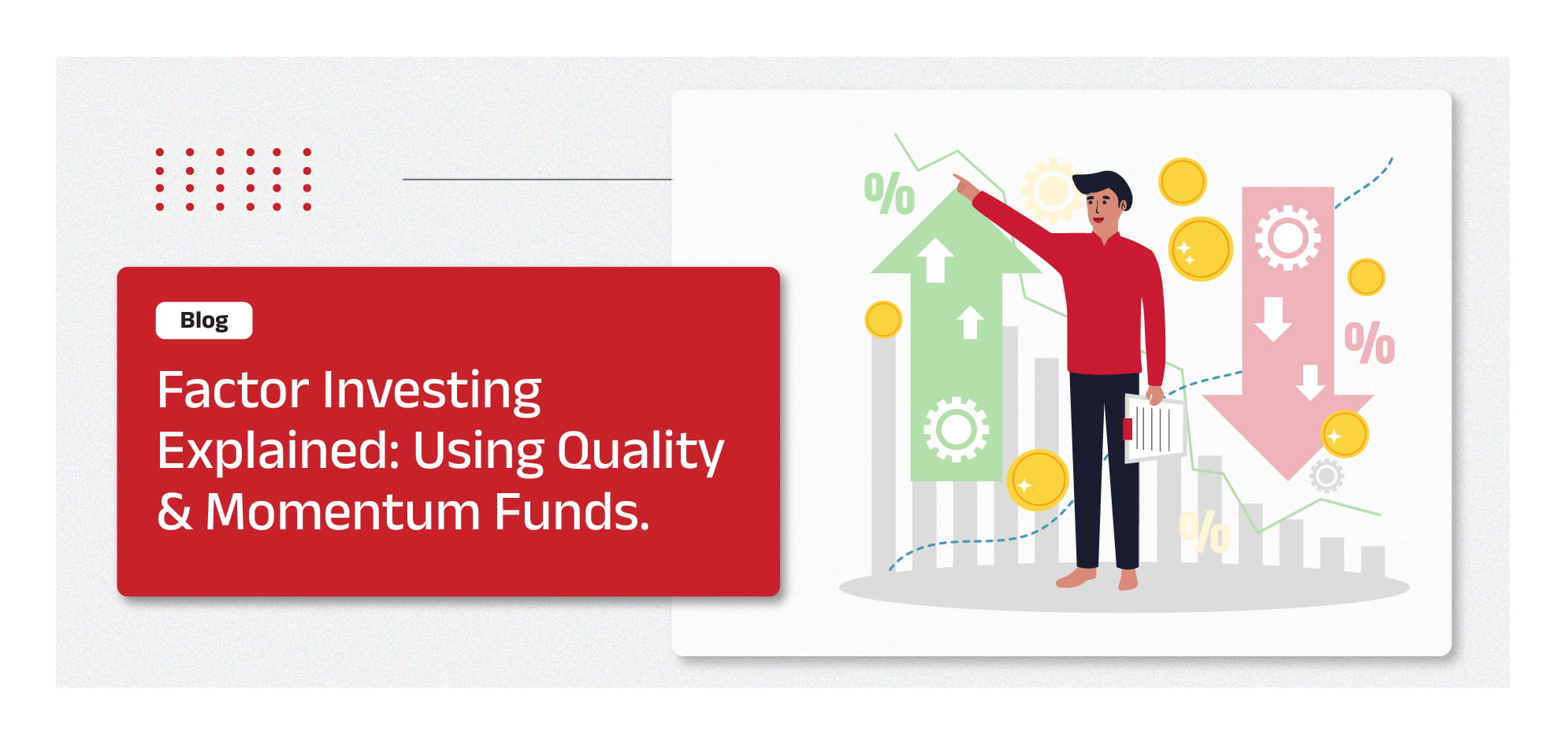-
Our Products
Our FundsFocus Funds
-
Self Care
Self-ServiceFind InformationWays To TransactPartner Solutions
-
Downloads
- Learnings
- About Us
-
More
-
Shareholders
-
Shareholders
-
Updates
-
-
SIP Calculators
- Back
-
Shareholders
What is Factor Investing? Exploring Quality & Momentum Index Funds

Aug 14, 2025
10 min
0 Rating
“Wealth is what you don’t see,” wrote Morgan Housel in his book The Psychology of Money. That hidden wealth often comes from quiet, disciplined decisions, like choosing where to invest. Factor investing is one such decision. It helps you build your portfolio based on proven traits like quality and momentum. These are not guesses or hunches. They are long-studied patterns that help filter the best from the rest. Rather than owning everything in a general index fund, factor investing gives you more control over what you own and why. This blog explains how quality mutual funds and momentum index funds work within this powerful strategy. So, read till the very end to understand it completely.
The Origins and Rise of Factor Funds
Factor investing is not a passing trend. It dates back to academic research in the 1960s and 1990s. Early studies by Fama and French showed that value and size were important drivers of returns. Later, Carhart added momentum to the list. Over time, this research moved from the classroom to the marketplace. By the 2000s, smart beta funds emerged. These are index funds that tilt toward specific factors while still following rules. Today, many providers offer momentum index funds or quality mutual funds based on these ideas. Recently, Indian fund houses have launched funds based on quality and momentum within the BSE 500. This shows how factor investing has evolved from theory to real tools that any investor can use.
Quality vs Momentum: What Makes Them Work
Quality looks at how healthy a company really is. Factors include strong profits, reliable cash flow, and low debt. Companies with high quality tend to survive tough times. Momentum is different. It rides on trends, buying recent winners and selling recent losers. It taps into investor behaviour like herding and side steps the long-term value debate. Momentum index funds usually pick stocks that have climbed over the past three to twelve months. Quality mutual funds pick firms that meet strict financial standards. You can combine both to get stability from quality and upside from momentum. Many fund houses now offer multi-factor or twin-factor funds that blend the two approaches.
How Factor Index Funds Work
Factor index funds follow rules, not opinions. First, they start with a broad market index like the BSE 500 or the S&P 500. Then they measure each company by the chosen traits. For quality, they look at metrics such as return on equity, debt ratio and earnings stability. For momentum, they measure recent price performance. The fund picks the top-scoring names and weights them according to the rules. These funds usually rebalance every quarter or six months to keep numbers fresh. They offer the discipline of passive investing with a tilt that could boost returns. Fees are generally higher than plain index funds but lower than active funds. This blend is why smart beta funds appeal as a middle ground.
Difference between Quality and Momentum Funds
Below is a table depicting a comparison between quality and momentum funds:
Feature |
Quality Funds |
Momentum Funds |
Focus |
Stability and strong financial health |
Recent rising stock prices |
Key Metrics |
Profitability, debt levels, and earnings |
3 to 12-month return performance |
Strength |
Withstand market downturns |
Capture strong up moves |
Weakness |
May lag in rapid rallies |
Can crash fast if the trend reverses |
Rebalance Frequency |
Quarterly or semi-annual |
Quarterly or monthly |
Best Market Phase |
Bear markets or choppy markets |
Bull markets or fast rallies |
Why Combine Quality and Momentum?
Mixing quality and momentum gives you balance. Quality adds a defence layer and helps in tough times. Momentum gives you the boost when markets rise. Together, they smooth out the ride. For example, markets may swing between fast growth and sudden drops. Quality cushions the fall, and momentum lifts you when the trend picks up. Multi-factor studies show that combining them can reduce volatility and improve returns in the long run. Some funds use dynamic factor rotation to shift weights based on market conditions. That can help you adapt without timing the market. It is a blend of smart ideas and rules-based strategy.
Benefits of Smart Factor Funds
Factor funds offer many advantages, such as:
They follow clear rules, so decisions are transparent.
As they are index-based, they tend to cost less than active funds.
They aim to add returns by focusing on proven factors.
Quality and momentum together can reduce risk from holding one type.
These funds rebalance regularly, which helps you avoid emotional mistakes.
You can use them to tailor your portfolio to your goals.
Risks and Things to Watch
Here are a few risks you should be aware of:
Quality funds may lag behind when cheap or risky stocks rise fast.
Momentum funds can lose heavily if the trend shifts quickly.
Rebalancing leads to transaction costs that may reduce profits.
Over time, many investors use the same strategies, which can dilute the effect.
Some factors may perform well in certain market conditions but not always.
Choosing the wrong factor mix may lead to poor returns.
Factors do not guarantee outperformance every year.
Timing factors are hard even for professionals.
You must be prepared for underperformance in the short term.
Emotional decisions can ruin the benefit of a disciplined approach.
How to Choose and Use Factor Funds
In order to choose the right factor funds and use them correctly, follow these simple steps:
Step 1: Know your investment goal. Do you want growth or protection from risk, or both
Step 2: Choose the right factor. Go for quality if you value safety. Pick momentum if you want fast growth.
Step 3: Look for funds that focus only on those traits or combine both through a multi-factor fund.
Step 4: Read the fact sheet to understand how the fund works and how often it rebalances.
Step 5: Compare costs. Smart beta funds are cheaper than active funds but more than plain index funds.
Step 6: Start small if you are new and build confidence.
Step 7: Hold for the long term. Do not chase short-term performance.
Step 8: Add these funds to your wider plan. They should fit in with other holdings like debt or large-cap funds.
Step 9: Review performance once or twice a year, but do not panic if it underperforms briefly.
Understanding ‘what is intraday trading’ also means accepting that errors happen. The goal is to learn and refine your approach.
Key Takeaways
Factor investing offers a smart and disciplined way to focus on qualities that matter. Quality mutual funds bring stability, and momentum index funds aim for growth. Combining them through smart beta funds gives you balance with reasonable costs. Risks remain, but with patience and clear goals, this strategy can help improve returns over time. Think of it as driving a car with both safety features and speed. Focus on what you want and use factor funds as a tool, not a magic solution. Be ready for the ride and stay the course!
The information herein is meant only for general reading purposes and the views being expressed only constitute opinions and therefore cannot be considered as guidelines, recommendations or as a professional guide for the readers. The document has been prepared on the basis of publicly available information, internally developed data and other sources believed to be reliable. Recipients of this information are advised to rely on their own analysis, interpretations & investigations. Readers are also advised to seek independent professional advice in order to arrive at an informed investment decision.
Mutual Fund investments are subject to market risks, read all scheme related documents carefully.





 1800-270-7000
1800-270-7000



